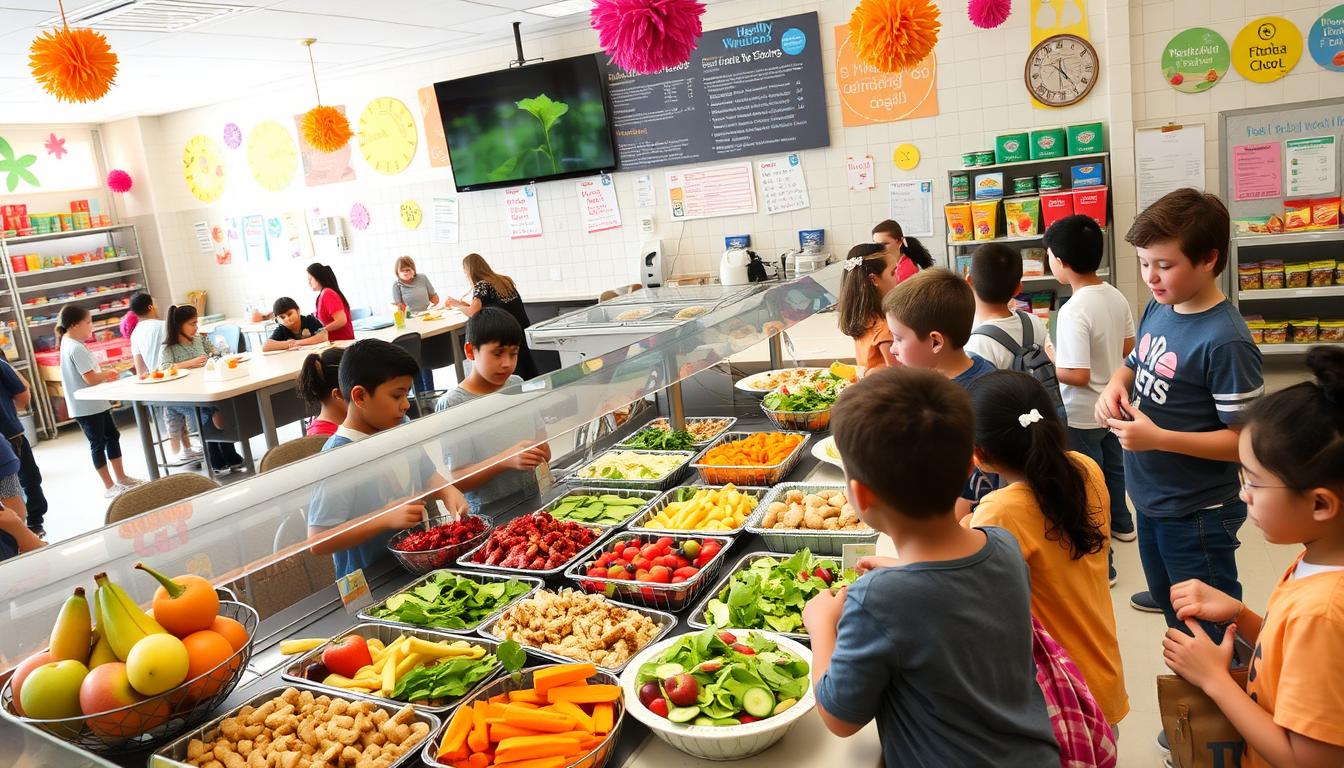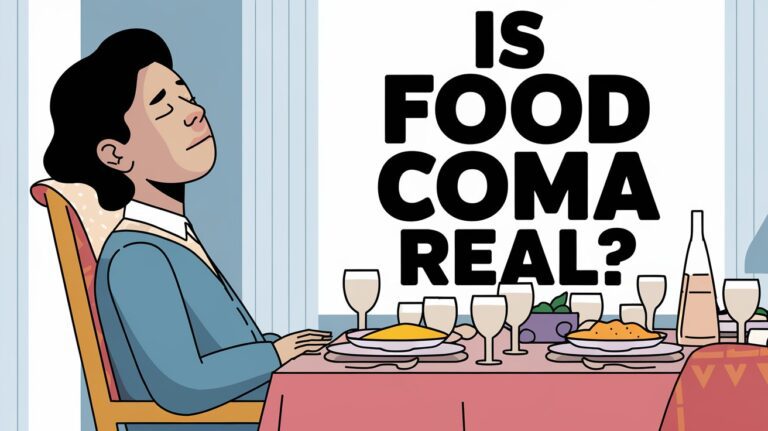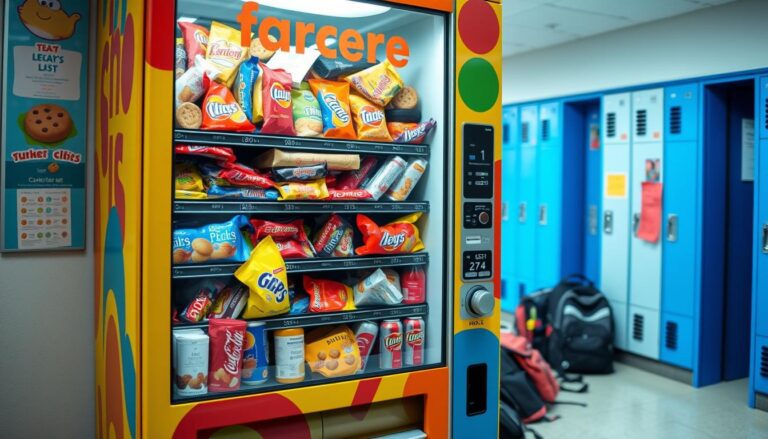Can Junk Food Provide Funding For School? The Benefits And Controversy
Many schools today face big budget problems. Especially in today’s political climate, education is woefully underfunded. Therefore, schools must find new ways to fund important programs. One idea is to sell junk food to raise money.
Vending machines, bake sales, and theses sorts of endeavors can be significant revenue streams for cash-strapped districts. However, this raises big questions about if it’s right thing to do when thinking about student health.
The use of junk food sales for funding has sparked a lot of debate. This debate includes educators, health advocates, and parents. It’s about fighting childhood obesity, which affects over one-third of the nation’s children.
As schools use less healthy food options for money, we must think about the health effects. This is important when looking at this funding strategy.
Childhood obesity is a big problem, and it’s worse in poor neighborhoods. Families there often struggle to get healthy food. Schools have to balance getting money and keeping students healthy.
It’s important to think about the short-term money gain and the long-term health effects. This includes how it affects what food is available in schools.
So read on, but me mindful of the big picture. Whatever opinion you have now, and whatever new opinion you might have after reading this article, realize that others have reached conclusions based on their own personal experiences. So disagreements are certain to persist, but with better understanding and education, the hope is that compromises will be easier to reach! You know?
Key Takeaways
- Schools face funding challenges, leading to increased reliance on junk food sales.
- Over one-third of children in the U.S. are overweight or obese.
- The debate around junk food in schools encompasses both financial and health perspectives.
- Lower-income families struggle with access to healthy meal options.
- Immediate financial relief might overshadow long-term health impacts on students.
Understanding the Concept of Junk Food Funding
Schools in the United States are finding new ways to raise money. One method is using junk food fundraising ideas. This helps schools get extra funds, which is important since education budgets are often tight. It’s key to understand how junk food funding works to see its benefits and drawbacks.
Definition of Junk Food
Junk food is highly processed and has little nutritional value. It’s full of calories, sugar, and unhealthy fats. These foods often miss out on important vitamins and minerals. This can lead to unhealthy eating habits among students.
Examples of Common Junk Foods
- Sugary sodas
- Potato chips
- Candy bars
- Fast food items like hamburgers and pizza
These foods are common in schools. They’re found in vending machines, lunch lines, and at fundraising events. Schools use these sales to raise money, even though they’re not the healthiest options.
How Schools Use This Funding
Money from junk food sales helps fund important school programs. It goes towards sports, arts, and basic school needs. As budgets get smaller, schools rely more on junk food sales. This raises questions about the impact on student health.
| Fundraising Method | Common Products | Budget Support Areas |
|---|---|---|
| Junk Food Sales | Sugary drinks, Chips, Candy | Sports Programs |
| Bake Sales | Cakes, Cookies | Art Classes |
| Snack Days | Chocolates, Popcorn | Field Trips |
The Financial Landscape of Schools Today
Schools in the United States face big challenges financially. Funding issues make it hard to improve education and resources. Many schools look for new ways to support their budgets.
Current Funding Challenges
Many schools struggle with less state and federal money. Over 95% of public schools are in the National School Lunch Program (NSLP). This program aims to offer healthy meals but often can’t keep up with costs.
The average lunch costs about $3.81 to make, but schools only get $3.32 from the government. This shows the big funding problems schools have.
Alternative Funding Sources
With tight budgets, schools look for other ways to get money. They use grants, partner with local businesses, and hold community events. They also have programs like farm-to-school initiatives.
In 2015, these efforts brought in $789 million. This money is crucial for schools.
Budget Cuts and Their Impact
Budget cuts hurt programs like arts and physical education. Schools now use less healthy ways to make money, like selling junk food. This worries about the health and well-being of students.
Schools have to find a way to balance making ends meet and keeping students healthy.
Pros of Junk Food Funding for Schools
Many schools struggle with money issues that hurt their education and programs. Junk food fundraising is a quick fix, bringing in funds for school needs. This money helps schools in many good ways.
Immediate Financial Relief
Junk food fundraising gives schools quick money when they need it. This money helps pay off debts and fund education. It lets schools keep or grow programs that might be cut.
This fast money helps schools run smoothly without interruptions. It’s a quick way to solve financial problems.
Enhancing School Programs
This money is key for better school programs. It helps with activities, trips, and learning tools. Schools using junk food sales can offer richer learning experiences.
These funds let schools focus on what’s most important. This makes programs better and more effective.
Community Engagement Opportunities
Hosting junk food events brings the community together. It involves parents, businesses, and students. This builds unity and support for schools.
Events like bake sales or food carnivals strengthen community ties. This support boosts fundraising and helps schools grow. A strong community means more help for schools in the future.

Cons of Junk Food Funding for Schools
The debate on junk food funding in schools is heated. It’s about the health risks of junk food. Some see it as a way to make money, but it’s harmful to students’ health.
Schools are where kids learn about food choices. But, if junk food is available, it can harm them. This can lead to serious health problems.
Health Implications for Students
Junk food in schools makes the childhood obesity problem worse. Research shows that unhealthy food choices lead to more obesity in kids. Students eat a lot of meals at school, and junk food is often the easy choice.
This can lead to poor health for students. It’s a big concern for schools and parents.
Long-term Effects on Dietary Habits
Regularly eating junk food can shape kids’ eating habits. Schools offering unhealthy snacks can make it hard for kids to choose better food later. This can harm their health for years to come.
Studies show that kids who eat junk food often prefer it over healthy food. This can be very bad for their health as adults.
Ethical Considerations
There are big ethical questions about junk food funding in schools. Schools need money, but junk food is bad for health. It’s a tough choice for schools.
Is it right to risk students’ health for money? This question sparks a lot of debate among everyone involved.
| Health Risks | Long-term Consequences | Ethical Dilemma |
|---|---|---|
| Increased obesity rates | Persistent unhealthy eating habits | Profiting from harmful products |
| Higher chances of chronic diseases | Higher risk of food insecurity | Against student well-being |
| Lower academic performance | Difficulty in social interactions | The balance between funding needs and health |
Case Studies: Schools Implementing Junk Food Funding
Schools across America have looked into different ways to boost their finances. They’ve turned to junk food sponsorship for schools. Looking at specific cases shows both the good and the bad sides of these efforts.
Successful Programs
Some districts have found success with fundraising programs based on junk food sales. For example, Marshall County Schools in Alabama made money by hosting events with fast food. This helped fund school resources and activities.
Miami-Dade County Public Schools also saw more people get involved. They did this by teaming up with well-known snack brands.
Lessons Learned
Schools that do well in fundraising share important lessons. Getting students involved in planning events makes them more likely to participate. Being open about how funds are used helps build trust with the community.
This way, junk food sponsorship for schools can be seen in a positive light.
Challenges Faced
Even with the financial gains, schools face many challenges. Parents and health groups worry about the quality of food sold. Schools must find a balance between what students like and what’s healthy.
This is a tough task. Some groups have seen their profits from food sales go down. This makes it harder to keep fundraising programs going.
Community Reactions to Junk Food Funding
People have mixed feelings about schools using junk food for money. Parents, students, and teachers all have different views. They worry about the health effects but also see the need for school funds.
Parent Perspectives
Parents worry about the health risks of junk food in schools. They want schools to find better ways to raise money. They are concerned that kids might get used to buying unhealthy food.
But, they also understand that schools need money. They see the need for quick help.
Student Opinions
Students like having junk food in school because it’s easy to get. They know schools don’t have much money for other things. But, they’re starting to learn about the dangers of obesity.
Some students want healthier food options. They want to stay healthy and feel good.
Teacher Insights
Teachers have different opinions on junk food in schools. Some see it as a way to get money for school programs. Others think schools should teach kids to eat healthy.
They believe schools should focus on both money and health. This helps students in the long run.
The Role of Corporations in School Funding
Corporations play a big role in school funding, but it’s a mixed bag. Fast food and corporate sponsorships in schools are complex. They expose young students to marketing that targets them directly.
Fast Food Chains in Schools
Big fast food chains partner with schools for meals in exchange for money. This deal seems good for schools that don’t have much money. But, it often means unhealthy food for kids.
Schools make more money, but face criticism for unhealthy food. This is a big issue.
Snack Brands and Sponsorship
Snack brands are everywhere at school events, sponsoring and giving out free snacks. This can help fund school programs. But, it also makes kids eat more unhealthy foods.
Marketing in schools leads to more sugary drinks and snacks. This goes against what’s good for kids’ health.
The Ethics of Corporate Influence
Corporate sponsorship in schools raises big ethical questions. Schools should focus on health, not profits. Critics say corporate influence hurts education, favoring business over students.
It’s hard for schools to be open and honest about funding. They have to deal with complex relationships.
Government Regulations and Guidelines
Government rules on school food are key to healthy eating in schools. The National School Lunch Program sets health standards for school meals. But, junk food is often more popular and cheaper for schools.
National School Lunch Program
The National School Lunch Program feeds millions of students daily. It follows strict nutrition rules. Yet, schools find it hard to stick to these standards.
Marketing and other food choices make it tough. One-third of kids face health risks from bad eating. So, these rules are crucial for their health.
Local Health Standards
States are making schools healthier by setting their own rules. Now, 39 states limit unhealthy snacks in schools. This shows a growing push for better food in schools.
About 80% of Americans back stricter food standards in schools. This shows broad support for healthier options.
Policies on Fundraising
Fundraising is big for schools, but rules can make it hard. Many events are limited by health standards or school lunch rules. These rules aim to keep food healthy but make fundraising tricky.
Schools must balance these rules with keeping their finances up and feeding students well.
Healthier Alternatives to Junk Food Funding
Finding healthy ways to fundraise for schools is key today. Schools are now focusing on better options instead of junk food. This shift helps keep students healthy and builds a strong community spirit.
Promoting Local Produce
By working with local farms, schools can add fresh fruits and veggies to their menus. This move supports local farmers and improves students’ diets. It’s a win-win for nutrition and school funds.
Fundraising Through Healthy Options
Schools can raise money by selling healthy snacks and meals. Options like fruit smoothies and whole grain snacks are popular. These choices appeal to parents and students who care about health.
Examples of Health-Conscious Initiatives
There are great examples of healthy programs in schools. Like vegetable gardens and cooking workshops for students. These programs teach kids about nutrition and help them make better food choices.

| Healthy Initiative | Description | Benefits |
|---|---|---|
| Farm-to-School Programs | Partnerships with local farms to supply fresh produce. | Improves nutrition, supports local economy. |
| Healthy Snack Sales | Offering nutritious snacks during fundraising events. | Generates funds, promotes healthy choices. |
| Vegetable Gardens | Establishing gardens on school property for fresh produce. | Encourages student engagement, teaches gardening skills. |
| Cooking Workshops | Interactive sessions teaching students healthy cooking. | Fosters a love of cooking, enhancing healthy eating. |
Future of School Funding: Trends and Predictions
The way schools get money is always changing. This change comes from new ideas in policy and what people think. It’s a time of both challenges and chances for schools to grow.
It’s key to understand these changes. This helps schools find new ways to fund themselves that fit what the community wants.
Shifts in Public Opinion
There’s been a big change in what people think about junk food in schools. More parents and health experts want to limit junk food in schools. They believe it’s better for kids’ health.
This shift means schools might need to focus more on health. They might have to find new ways to get money that don’t involve unhealthy foods.
Potential Policy Changes
New policies could change how schools get money. Rules might make it harder for schools to sell certain foods. This shows how important health and green ideas are in school policies.
Schools might need to look for new ways to fund themselves. This could mean finding money that doesn’t hurt kids’ health.
Innovative Funding Solutions
Schools are looking for new ways to get money because old ways aren’t working. They’re teaming up with the community, applying for grants, and using crowdfunding. These methods help schools get the money they need and make schools healthier places.
Working together is going to be key for schools’ future. It will help make sure kids have what they need to succeed.
Conclusion: Finding a Balance Between Funding and Health
The debate on junk food in schools highlights a big issue. Schools need money, and junk food can bring it in. But, it’s bad for kids’ health. For example, schools make a lot from selling junk food, around $10,850 to $15,233 a year.
It’s important for everyone to talk about this. Teachers, parents, students, and leaders need to work together. They should find ways to fund schools without harming kids’ health. Laws that help schools focus on healthy eating are a good start, but we need to keep talking.
Everyone must play a role in making schools healthier. We need to support policies that help kids eat better. This way, schools can fund their programs and keep kids healthy. It’s a big challenge, but we can do it if we all work together!







